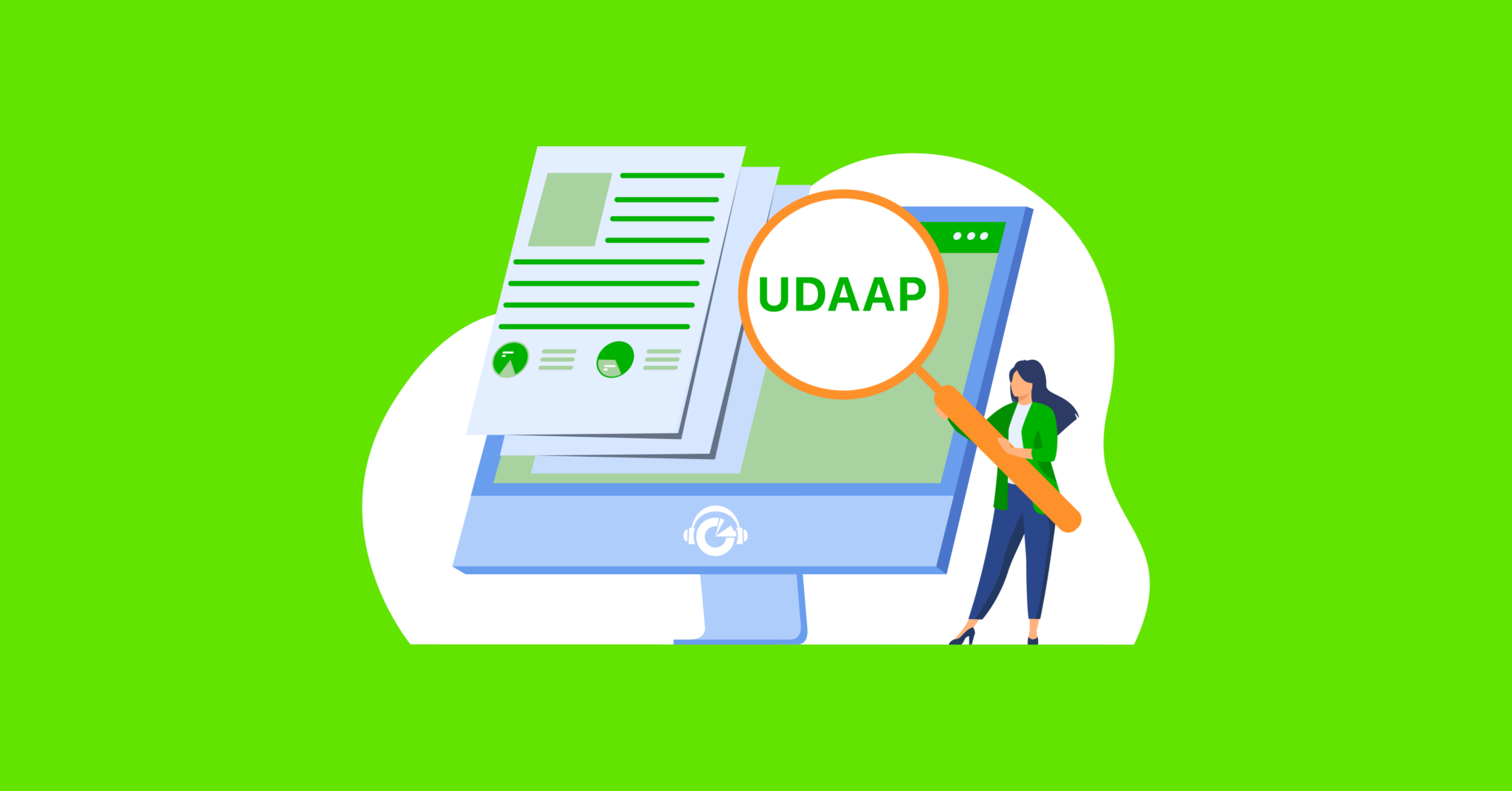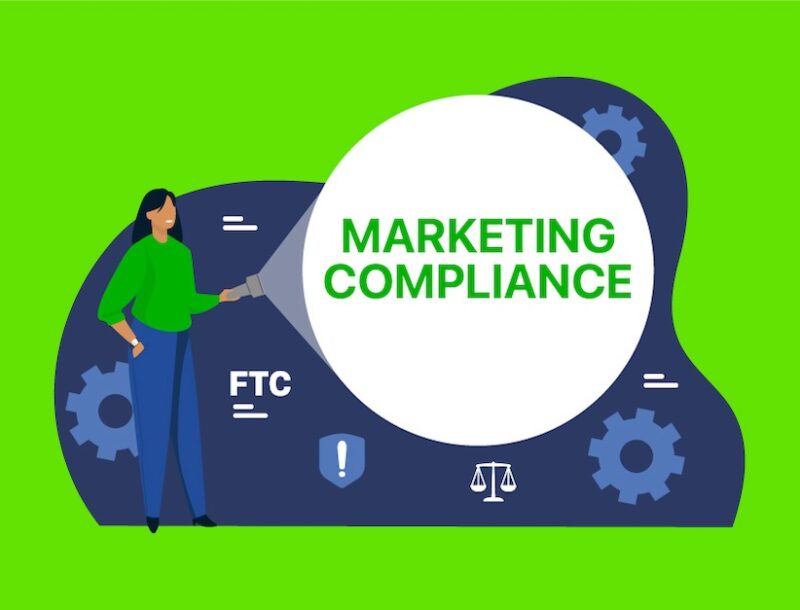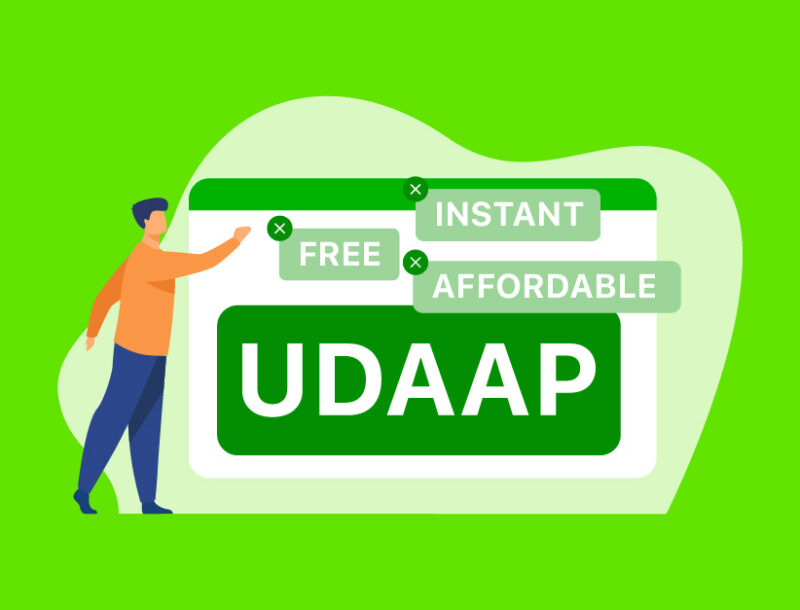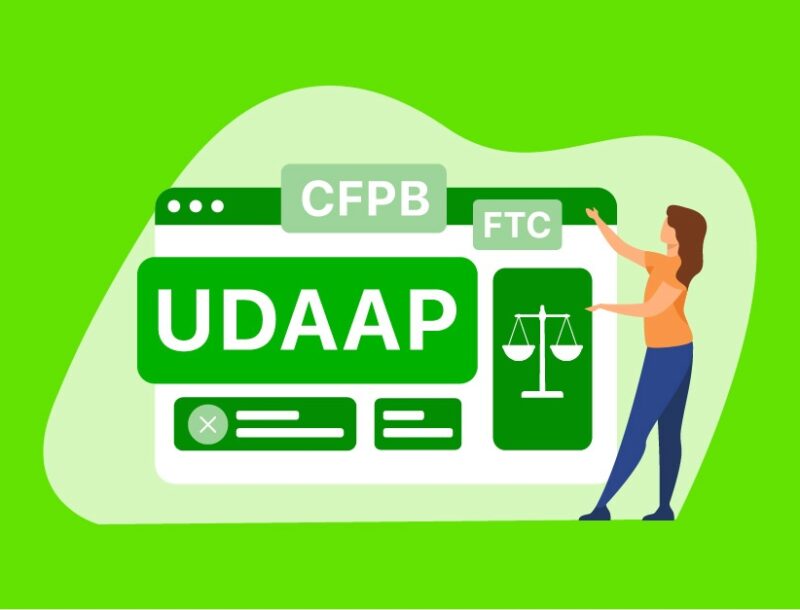Episode 25: UDAAP Compliance Trends and Best Practices Pt. 1

Episode Description
This COMPLY Podcast episode is the first part of a conversation between four industry experts—James Kim from Troutman Pepper, Brian Serafin from Weiner Brodsky Kider PC, Pia Thompson from lawesomeGC, and Rhonda McGill from PerfomLine.
Today they discuss their unique insights on compliance with Unfair, Deceptive, or Abusive Acts or Practices (UDAAP). Listen as they discuss:
- Background on UDAAP
- Compliance risks to be aware of as it pertains to UDAAP
- Their takes on the CFPB’s policy statement on abusive acts and practices
Show Notes:
- The Top UDAAP Compliance Issues Report: https://bit.ly/43lT1FB
- Watch On Demand – Minimizing UDAAP Compliance Risks: https://bit.ly/45qzuWm
- UDAAP Resource Library: https://bit.ly/3IAYW1I
- Connect with Pia Thompson: https://www.linkedin.com/in/pia-thompson/
- Connect with James Kim: https://www.linkedin.com/in/jameskim99/
- Connect with Brian Serafin: https://www.linkedin.com/in/brian-serafin-23297620/
- Connect with Rhonda McGill: https://www.linkedin.com/in/rhonda-mcgill/
Subscribe to COMPLY: The Marketing Compliance Podcast
About COMPLY: The Marketing Compliance Podcast
The state of marketing compliance and regulation is evolving faster than ever, especially for those in the consumer finance space. On the COMPLY podcast, we sit down with the biggest names in marketing, compliance, regulations, and innovation as they share their playbooks to help you take your compliance practice to the next level.
Episode Transcript:
Ashley:
Hey there COMPLY Podcast listeners, and welcome to this week’s episode. This week’s podcast is the first part of a conversation between four industry experts, including James Kim from Troutman Pepper, Brian Serafin from Weiner Brodsky Kider PC, Pia Thompson from lawesomeGC, and Rhonda McGill from PerfomLine. Today they discuss their unique insights into compliance on unfair, deceptive, or abusive acts or practices, or more commonly referred to as UDAAP. Listen as they discuss background on UDAAP, compliance risks to be aware of as it pertains to UDAAP, and their take on the CFPB’s policy statement on abusive acts and practices. Thanks for listening and enjoy.
Rhonda:
Hi, good afternoon everyone. My name is Rhonda McGill and I am the Senior Director of the Client Success Team here at PerformLine. Today we wanted to get together with some of our friends to talk about minimizing UDAAP compliance risk. And thank you all again for joining us today. I think this is an important topic that really has peaked interest and during this campaign for UDAAP, we’ve seen quite a few of our folks have expressed a lot of interest in the content that we’ve been putting out. So with that said just to give some of that background as we’re talking about UDAAP, we know that UDAAP has evolved throughout the years, and most notably in the 2007, 2008-ish, crisis with the financial sector, Congress started issuing that authority to the states and banking agencies and then the creation of the CFPB in 2010.
Rhonda:
The financial services industry has changed so much throughout the years and it’s continuously evolving and oftentimes it’s going at a faster clip than what our regulators are even able to keep up with. But it’s still incumbent on the businesses to stay on top of these evolving regulations. What do you recommend companies do so that they can stay up to date with UDAAP regulations and the many emerging issues and trends within it? I can turn it over to whomever would like to jump in and start on that one.
Pia:
Well, as in-house just super quick, I think it’s important to have your council kind of selected so that you’re not always reacting. And so those are an extension of your in-house legal department, and so they’ll notify you. They will know about your business in addition to you know, services and outside vendors that aren’t law firms, but are heavily embedded in the space because it’s very hard in-house to be up to date on all of those things. Even with the compliance department, even with regulatory lawyers, we have company things that we’re focused on.
Rhonda:
Brian, were you were going to say something?
Brian:
Yeah, no, I was just going to say one of those things actually that I found to be really helpful, the CFPB publishes something, it’s about two or three times a year, yhey’re called supervisory highlights. Basically they’re reports of violations that the CFPB has been discovering during their examinations. Obviously exams are confidential, so it’s all on a no-name basis, but I found it actually, it’s a pretty helpful source to identify either a. issues that they’ve suddenly seen a lot of people committing, or b. it’s kind of a place where they start to sort of put out the first notions when they have a new legal theory. Those sort of identified in some of these highlights. And I’ve actually found this be really useful just as a place where they kind of telegraph swhat they’re intending to do going forward. And you know, the CFPB they publish a lot of material late. Their guidance statements, they have blog posts and articles on their website, which are a little more consumer-oriented. But again these publications, they tend to be a pretty good way to find out what’s coming down the hill.
Pia:
And Brian, thank you for pointing that out because one of the things we do is we summarize the quarterly enforcement actions for CFPB that impacts our business. And for example in California, the DFPI, or other states that have an active state bureau so that the board is being updated with respect to our industry. So Brian, that was a great reminder that somebody in the compliance department that is their gig for the board materials, each quarter.
Rhonda:
Absolutely. It’s so important. And I think so often boards are kind of the last to know. So that’s a great call out about the importance and the duty of the board.
James:
Yeah. Just to add on that and I agree with both Pia and Brian, so I want to just kind of add to what they’re saying, build on it. I agree with Brian a hundred percent that the CFPB’S quarterly supervisory highlights are often a precursor to kind of more aggressive legal theories that they will eventually assert or are asserting non-publicly in an enforcement action. And you don’t see the output until a year later in a public consent order. So that’s why you gotta review the supervisory highlights in tandem with the enforcement orders, because I think that gives you a better kind of more complete picture. And then to kind of piggyback on one of Pia’s comments, UDAAP present a lot of challenges but it’s not for lack of information. Because there are a lot of bulletins and guidance and consent orders and it’s almost overwhelming, right, if you’re in-house?
James:
So I think one of the ways that outside counsel can help you is not only just staying abreast, because a lot of people can kind of stay abreast of these developments because they’re mostly public, not always. But it’s understanding how a consent order supervisory highlight, which the fact pattern may be kind of vague or not applicable to you, how that will translate to your business model or your product. So having that knowledge either in-house or outside counsel of what you do of your particular issues and product offerings and transferring the kind of the data sources that can be overwhelming and sifting through it to say this, is what’s relevant and specifically how is it relevant to you or to us.
Rhonda:
Makes a lot of sense. So recently the CFPB issued a policy statement on Abusiveness to address the changing market. And in a recent speech I cannot remember where it was at, but I’m going to kind of paraphrase what Director Chopra had said because it really was a explanatory background where he said the abuse of prohibition is focused on a company’s conduct that obstruct people’s ability to digest information, whereas deceptions are more concerned with words and abusive actions. So can each of you share some of your thoughts about the policy statement and what do you believe are some of the important takeaways that we should be aware of? Especially, I’m looking at like AI and how that’s starting to emerge. As these things continue to emerge, what are some of the things that you can think of that people should be aware of as applies to that abusiveness policy statement? Let’s start with Brian.
Brian:
Sure. No, I think the abusive standard it’s interesting because obviously the statute covers unfair, deceptive or abusive acts or practices. And the unfair or deceptive components are fairly well known. I think those two parts, unfair deceptive came from the Federal Trade Commission Act, in like 1938. So those have been around a long time, a long time. They’ve been deeply interpreted by courts. Whereas this abusive prong that kind of came into the CFPB statute is somewhat newer. And so there has been a lot of effort to try and figure out what is abusive that would not otherwise also be unfair or deceptive. What does abusive bring to the game that wasn’t already there? So that was why the new policy statement that they issued was pretty interesting. Again it seems like they’re focused, they sort of put it under two components. Basically they really don’t want people to be taking advantage or unreasonable advantage of consumers. Just based on sort of circumstances that might arise around the transaction. It might not even be something that the lender, the financial service provider set up, but just something that’ll prevent the consumer from either understanding the product that’s before them.
Pia:
Brian, can you give some kind of concrete example of that? Because one of the frustrations, I think that I find is it’s also nebulous and it’s a way for them to back in, you know, anything to UDAAP. I wasn’t so convinced that this policy statement helped really. So if you could give any examples of how you think it would help a company dealing with consumers, that would be great.
Brian:
Sure. So, again, you know, one of the big things it looks like is that they’re very skeptical disclosures and fine print. And one of the things I’ve noticed they’ve taken a big interest in websites. So you might have someone signing up for a service on a website for example the disclosure might be presented, but if you have to click through a couple extra buttons to get there, or if it’s somewhere on the page where it’s just a little harder to see than the buttons you put to go through the signup process. So that’s one of those kinds of things that they seem to be focused on.
Pia:
Okay. And on that, I wanna say something very specific on that. So this is something that I’ve have to explain to my companies on a regular basis is, and I’ve had more than one State Attorneys General say two more things. We understand that there isn’t a consumer on the planet who will read any of your stuff. We are the ones who will read it and we will judge it. And so I get a lot from my business folks who are like, we’re not putting in three extra click buttons and nobody reads it. And so I think that is something we have to highlight is, let’s stop with the charade that we are putting this together for consumers.
Pia:
We are putting it together for regulators because it’s what they want to see. Because we actually don’t want people buying our products who don’t understand what they’re getting. That’s actually nothing for business to have people confused. But what’s actually in the words, you have to go over and over it for how the regulators are going to read it. Is what I find, and especially when they’ll say that to your face that we don’t actually care if any consumer was ever confused. Like they don’t need that.
Rhonda:
Right. And I think about the most recent thing around the legion and who’s paying the most to get their name in the top 10 or whatever the list is. I think that’s another perfect example of where they are going with this type of a thing. Brian, or James, would you wanna?
James:
Yeah, just to weigh in a little bit you know, these are some great observations. I agree with Pia that you’re doing this for the benefit of the regulator, not the consumer. And I’d say, what else would I add to that about the abuse of this policy? It used to be that if you disclose things well and you had proper kind of process, right? Clear flow, clear disclosures, people get to click and see things that was adequate. I think the abusiveness and the policy statement and also kind of their whole application of unfairness really is about outcomes, right? So the process that flows, the disclosures can be great, but if they just don’t like the outcomes either at an individual transaction level or at an aggregate level, they’re going to just assert unfair and abusive.
James:
So the CFPB sadly is a result oriented agency. You know, people talk about process, they’re not a process driven, right? Processes, you have public notice and comment. You have a fair transparent process. People and companies know the rules of the road, the CFPB they have their idea of what their outcome is, and then they play a little bit of gotcha with you, right? So what does that mean for companies? So one of the ways I try to give practical advice is really what the CFPB and others want is almost a fiduciary duty. And my colleagues joke with me and they say, James, strike almost, they want a fiduciary duty.
Rhonda:
A fiduciary duty, yes.
Pia:
And so that’s the reason why I like using that concept, you’ll never see that word anywhere in CFPB literature, but I like to use it as a good practical kind of way of explaining to companies, because people understand fiduciary duty and product suitability in other fields like security so they can transfer it. Right?
Pia:
I just wanted to say, like for the audience, if you could kind of really break that down, like what do you mean when you say fiduciary duty, like in our world, what would that look like?
James:
I mean, that means you have to not just be honest and transparent the consumer, you have to look out and protect their interests. You’re taking it to another, they are your fiduciary. You owe them a fiduciary duty, right? That’s the outcome. Like, you have to give the consumer a good, fair outcome. It’s not enough to just say, caveat, I disclose, and if you do whatever you do, that’s on you, not on me. That’s not good enough. That’s fiduciary duty. And the one other thing I’d say about the policy statement, I’d love to get people’s reaction to it, is it’s, again, not in the policy statement, but Director Chopra’s kind of testimony, I think it was testimony, or it might have been his press conference announcing the policy. I think he let the cat out of the bag a little bit. To Brian’s point, there’s a lot of precedent and guidance around unfair and deceptive. And when Chopra was at the FTC, he was often critical of the FTC and what they did and didn’t do. And so what Director Chopra said in his, I think it was testimony, but it was public remarks, is he likes abusive. I’m paraphrasing because it’s not bound by the precedent that he doesn’t like about unfair and deceptive. So he has a clean slate to, to do whatever he wants, and all the adverse guidance and precedent and cases on UDAAP with 1a, like irrelevant to him, like no barrier.
Rhonda:
Yeah
Brian:
I think particularly again, in the financial service industry, this can kind of become an issue. For example, if a consumer is working with a mortgage officer or a bank consultant about which mortgage should you get or which account should you open, the mortgage officer, the bank consultant, they kind have an interest in making the sale.
Brian:
Oftentimes will be the product that’s best suited for the customer, but maybe sometimes some differences of opinion of what’s the best product. And again, I guess the CFPB really doesn’t want customers to get the impression you’re solely focused on picking the product that’s the exact perfect one for them.
Rhonda:
For sure.
Brian:
They don’t want the customer to think that.
Pia:
And, Rhonda, I want to go to one of the things you said in the intro about so much of this obviously came out of 2008 and the mortgage crisis and the financial crisis, and Brian, you just mentioned mortgage officers. Well, one of the things that I have found over the last 15 years is the agencies and the regulators don’t seem to understand the difference between a secured and unsecured product. And so I think a bunch of these concepts, I’m not saying they’re completely irrelevant, but ability to repay when it is not tied to your home, when it is not tied to all these other things, is that so relevant? Or is that perhaps in infantilizing of the consumer who needs the loan to make their own decisions. They need this lump sum, they can make their own decisions about what they’re going to pay back and what their choices they’re going to make from their monthly budget. Right. And so they’re being kept from getting this lump sum because of a tool that wasn’t really meant for that product. And so James and Brian, I’d love to kind of get your feedback on that because I’ve had some difficult times with the Department of Justice with all sorts of agencies where no matter how many times I explain it’s an unsecured product, they don’t get it and they don’t care.
Brian:
So one of the things that’s sort of interesting, again, this is with the CFPB and with some of this consumer protection generally, in a lot of areas, the lot will ask what would the reasonable person do? What would be the reasonable person’s answer? But when you get into consumer protection, particularly, for example, in dealing with the CFPB, they’re more focused on what would be least sophisticated consumer value.
Brian:
So again they’re bending over backwards to kind of make all inferences in favor of the consumer might be one way to look at it. So again part of it is, what are consumers going to understand basically in some ways that almost has to be spoon fed to them? Or how do you highlight what are the most important parts? So you’re not overloading them with a pose full of words that not all of them are going to get through. I think that’s important. And again as far as your point of the unsecured loans, I think that goes to making them understand what are the consequences if you, for example, don’t pay back what you owe. Making sure they understand that.
James:
Yeah, I agree. Just taking my shot at Pia’s question. I agree. It’s very paternalistic. You know, I think sometimes the government folks cross the line and in the name of consumer protection, they’re really picking winners and losers in the marketplace. And it just some kind of contextual data points, like when Elizabeth Warren over the years talks about the post office offering loans and banks make too much money. I mean, all of that indicates like in her mind, in people who think like her, that it really banking should be just a utility that’s a kind of a low profit, widely accessible kind of a vanilla product for everybody. And the problem with that is, you lose innovation, you lose competition. So as a fintech focused practitioner, one of my common challenges is explaining, educating, defending like a kind of a novel product to a regulator because they’re so robotic and rigid in their thinking. If it doesn’t fit neatly in a regulated box, they’re immediately very skeptical of it and they think it’s harmful and they don’t realize that it’s often a market driven positive alternative to existing products or an existing problem or gap in the marketplace.
Pia:
Well and on that topic to take it out to some concrete examples, so I have two things on this having loans available at libraries or at the post office. I was speaking with someone from the CFPB and I had a high interest loan product, and this guy at the CFPB said, well, I don’t understand why these people aren’t going to banks. And so I said, I agree with you, and I don’t know why they don’t have private bankers too, because it’s so nice, like I’ve never had to call a toll free number. I don’t understand, why don’t they do that? And it was just so obnoxious on his part. We’re talking about people who don’t have every option.
Pia:
And then here’s the second thing, and it goes really directly to this post office idea. So I’ve been in the subprime space a lot and in the prime space, but in the subprime space, what are the states doing? They are putting in interest rate counts, right, of 36%. Well, that doesn’t mean subprime people get 36% loans. It means they don’t get any loans. And so if the government has an issue with very high percentage rates that have to exist for two reasons, right? They exist because of defaults and they exist because of cost of capital? And who has the least cost of capital? National banks. Back in the day there 10 years ago, their cost of capital was zero. And they still won’t make these loans. So then you go to the fintechs who sometimes have 12%, 14% cost of capital, then they have big default rates. And so to be able to offer the product, the math, is the math and you end up with these higher rates. And so because subprime lenders are demonized, they [regulators] decide we’re putting in account, that’ll be the end of this.
Pia:
Well, you know what, if you wanna put subprime lenders out of business and not have 50, 60, 90% interest loans, go ahead, give loans at the post office for 30%. And maybe it is a public good that as taxpayers, we subsidize the defaults, right? That’s a whole philosophical discussion as to what we should do as a society. But let’s have that discussion, but instead they just ban it. And so James, I think that really goes also to your point where stop talking about it; if you’re going to do it, do it. But instead what you’re doing is you’re taking this huge group of the American population and saying you don’t get credit.
Rhonda:
Thank you for that. That was a great discussion.
Ashley:
Thanks for listening to this episode of the COMPLY Podcast. Many of the key topics of discussion today are highlighted in our Top UDAAP Compliance Issues Report, which I will drop for you in today’s show notes. And if while listening to our podcast today, you realize you may need to prioritize incorporating UDAAP into your marketing compliance program, I’m also going to include a link to our UDAAP resource library. It has a number of helpful pieces to help you better understand and prioritize UDAAP compliance. As always, for the latest content on all things marketing compliance, you can head to content.performline.com. Thanks for listening and we’ll see you next time.


